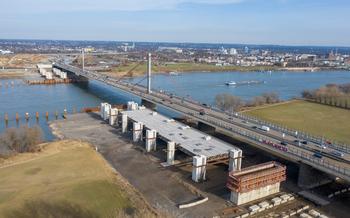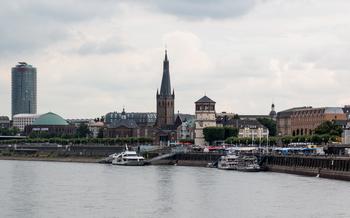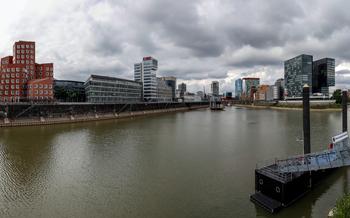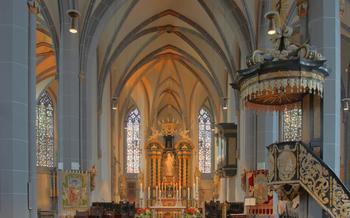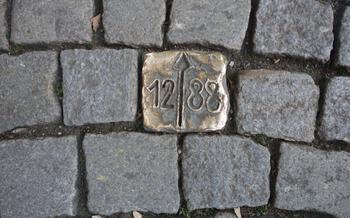
The Rider (Jan Wellem Reiterstandbild)
- History of the Rider (Jan Wellem Reiterstandbild)
- Description of the Rider (Jan Wellem Reiterstandbild)
- Location and Surroundings of the Rider (Jan Wellem Reiterstandbild)
- Jan Wellem, the Elector Palatine
- Restoration and Conservation Efforts
- The Rider (Jan Wellem Reiterstandbild) as a Cultural Icon
- Photography Tips for Capturing the Best Shots
- Historical Context of the Statue's Creation
- Artistic Legacy of the Rider (Jan Wellem Reiterstandbild)
- Interactive Experiences and Activities
- Accessibility and Facilities
- Insider Tip: Unveiling the Secrets of the Rider
History of the Rider (Jan Wellem Reiterstandbild)
The Rider (Jan Wellem Reiterstandbild) stands as a testament to the rich history of Düsseldorf and its illustrious former ruler, Jan Wellem. Created in the 18th century, this iconic equestrian statue holds a significant place in the city's cultural and historical landscape. Commissioned by Jan Wellem himself, the sculpture was crafted by the renowned sculptor Gabriel Grupello and cast in bronze by Kaspar von der Heiden. Unveiled in 1711 amidst great fanfare, the statue quickly became a beloved landmark, capturing the essence of Jan Wellem's reign and his profound impact on Düsseldorf.
Throughout its existence, the statue has been a subject of fascination and controversy. Its symbolism and artistic style have sparked debates among art historians and enthusiasts alike. The statue's depiction of Jan Wellem, astride his majestic horse, Bayard, has been interpreted as a symbol of his power, authority, and military prowess. However, the statue's grandiose scale and elaborate ornamentation have also been criticized for their perceived extravagance and ostentation. Despite these controversies, the Rider remains a beloved symbol of Düsseldorf, embodying the city's rich heritage and cultural legacy.
Description of the Rider (Jan Wellem Reiterstandbild)
The Rider (Jan Wellem Reiterstandbild) stands as a testament to the artistic brilliance of the Baroque era. Cast in bronze and towering at an impressive height, the statue showcases intricate details that capture the essence of both Jan Wellem and his beloved horse, Bayard. The sculpture exudes a sense of power and grandeur, with Jan Wellem depicted in full regalia, his commanding presence accentuated by the intricate armor and flowing cape.
Bayard, the horse, is portrayed with equal attention to detail, its muscles rippling beneath its sleek coat, conveying a sense of strength and agility. The intricate mane and tail add to the realism of the sculpture, creating a sense of movement and dynamism. The bond between Jan Wellem and Bayard is palpable, symbolized by the rider's firm grip on the reins and the horse's attentive gaze towards its master.
Unique features set the statue apart from other equestrian sculptures. The inclusion of a turban on Jan Wellem's head, a nod to his fascination with the Orient, adds a touch of exoticism to the otherwise traditional portrayal of a European ruler. The elaborate pedestal, adorned with intricate carvings and reliefs, further enhances the statue's grandeur and contributes to its overall artistic significance.
Location and Surroundings of the Rider (Jan Wellem Reiterstandbild)
The Rider (Jan Wellem Reiterstandbild) occupies a prominent position in the heart of Düsseldorf, making it a focal point of the city's cultural and historical landscape. Situated in the Burgplatz square, the statue stands tall, commanding attention from all corners of the plaza. Its central location ensures that it is easily accessible to visitors, who can reach the statue on foot, by public transportation, or by car.
The Burgplatz square, where the statue resides, is a vibrant hub of activity, surrounded by notable landmarks and attractions that contribute to Düsseldorf's rich heritage. The Old Town Hall (Altes Rathaus), with its distinctive Renaissance architecture, stands adjacent to the square, offering a glimpse into the city's past. The St. Lambertus Church, with its towering spire, adds a touch of grandeur to the surroundings.
Other notable attractions in the vicinity include the Schlossturm (Castle Tower), a remnant of Düsseldorf Castle, and the Kunstakademie Düsseldorf, a renowned art academy that has produced many notable artists. The Königsallee, Düsseldorf's famous shopping boulevard, is just a short walk away, inviting visitors to explore the city's modern side.
With its central location and proximity to other landmarks, the Rider (Jan Wellem Reiterstandbild) is seamlessly integrated into the fabric of Düsseldorf's urban landscape, making it a must-visit destination for anyone interested in exploring the city's cultural and historical treasures.
Jan Wellem, the Elector Palatine
Jan Wellem, born Johann Wilhelm, was a prominent figure in the history of Düsseldorf and the Rhineland. Born in Düsseldorf in 1658, he inherited the title of Elector Palatine and became the ruler of the Palatinate in 1690. His reign marked a period of prosperity and cultural flourishing for Düsseldorf.
Jan Wellem was a passionate patron of the arts and culture. He transformed Düsseldorf into a vibrant cultural center by attracting renowned artists, architects, and musicians to his court. His patronage led to the construction of magnificent palaces, churches, and gardens, including the iconic Schloss Benrath. He also established the Düsseldorf Art Academy, which became a renowned center for artistic education.
Beyond his contributions to the arts, Jan Wellem was a skilled politician and diplomat. He played a crucial role in mediating conflicts and maintaining peace in the region. His diplomatic efforts earned him the title of "Peacemaker of Europe."
Jan Wellem's legacy extends far beyond his lifetime. His vision and patronage have left an indelible mark on Düsseldorf, shaping its identity as a cultural and artistic hub. He is remembered as one of the most influential rulers in the city's history, and his contributions continue to be celebrated and cherished by its citizens.
Restoration and Conservation Efforts
The Rider (Jan Wellem Reiterstandbild) has undergone several restoration and conservation projects over the years to maintain its integrity and preserve its historical significance. In the early 19th century, the statue was cleaned and repaired, and its bronze elements were treated to prevent corrosion. In the 1950s, a more extensive restoration project was undertaken, which involved removing the statue from its pedestal, cleaning it thoroughly, and repairing any damage. The horse's tail, which had been damaged during World War II, was also restored.
In recent years, the statue has been subjected to regular inspections and maintenance to ensure its continued preservation. The bronze surface is regularly cleaned and polished, and any signs of wear or damage are addressed promptly. The statue's pedestal is also monitored for any signs of structural issues or movement.
The restoration and conservation efforts for the Rider (Jan Wellem Reiterstandbild) are crucial in preserving Düsseldorf's cultural heritage and ensuring that this iconic landmark remains a source of pride and inspiration for generations to come.
The Rider (Jan Wellem Reiterstandbild) as a Cultural Icon
The Rider (Jan Wellem Reiterstandbild) has transcended its role as a mere statue to become a cultural icon deeply embedded in the identity of Düsseldorf. It is a symbol of the city's rich history, artistic heritage, and civic pride. The statue's distinctive silhouette has become synonymous with Düsseldorf, gracing countless postcards, souvenirs, and promotional materials.
The Rider has inspired numerous works of art, literature, and popular culture. It has been featured in paintings, sculptures, poems, and even songs, each capturing a different facet of its significance. The statue's iconic status has also made it a popular subject for local festivals and events, including the annual "Reiterfest," which celebrates Jan Wellem's legacy and the city's equestrian traditions.
Beyond its symbolic value, the Rider has played a crucial role in promoting tourism and city pride. Its unique beauty and historical importance attract visitors from around the world, eager to witness this remarkable work of art firsthand. The statue's presence has transformed Burgplatz into a vibrant public space, where locals and tourists alike gather to admire its grandeur and soak in the city's rich atmosphere.
The Rider (Jan Wellem Reiterstandbild) stands as a testament to Düsseldorf's cultural heritage and its enduring appeal. It is a beloved landmark that continues to inspire and captivate, serving as a source of pride for the city's residents and a symbol of its vibrant cultural identity.
Photography Tips for Capturing the Best Shots
To capture stunning photographs of the Rider (Jan Wellem Reiterstandbild), consider the following tips:
-
Angles and Perspectives: Experiment with various angles to find unique perspectives that showcase the statue's grandeur. Shoot from a low angle to emphasize its imposing presence, or capture a side shot to highlight its intricate details.
-
Lighting: Natural light plays a crucial role in photography. Visit during the golden hours of sunrise or sunset for warm, diffused light that enhances the statue's textures and colors.
-
Composition: Utilize the surrounding environment to create a visually appealing composition. Include elements like trees, buildings, or the bustling city life to add depth and context to your shots.
-
Creativity: Don't be afraid to experiment with different techniques to create unique and creative shots. Use long exposure to blur the movement of the surrounding traffic, or capture reflections of the statue in nearby water bodies.
Historical Context of the Statue's Creation
Düsseldorf, in the 17th and 18th centuries, was a thriving cultural and artistic hub. During this period, the city witnessed a flourishing of Baroque art and architecture, characterized by its grandeur, opulence, and intricate details. The creation of the Rider statue was deeply rooted in this artistic movement.
The Baroque period, which dominated Europe from the late 16th to the mid-18th century, emphasized drama, emotion, and elaborate ornamentation. Equestrian sculptures, like the Rider, were particularly popular during this time, symbolizing power, authority, and military prowess.
Equestrian statues were often commissioned by wealthy patrons to commemorate important rulers or military leaders. In the case of the Rider, Jan Wellem, the Elector Palatine, was the driving force behind its creation. Jan Wellem was a passionate patron of the arts and sought to beautify his city with magnificent works of art.
The statue was created at a time when Düsseldorf was undergoing a period of significant growth and development. Jan Wellem's reign marked a golden age for the city, with numerous cultural and architectural projects undertaken. The Rider statue thus became a symbol of Düsseldorf's prosperity and growing importance as a cultural center.
Artistic Legacy of the Rider (Jan Wellem Reiterstandbild)
The Rider (Jan Wellem Reiterstandbild) stands as a testament to the artistic prowess and influence of its creator, Gabriel de Grupello. Its impact on the artistic landscape of Düsseldorf and beyond cannot be overstated. The statue's grandeur and intricate details inspired subsequent generations of artists and sculptors, shaping the city's artistic identity.
Grupello's masterpiece influenced the creation of numerous equestrian sculptures and monuments across Europe. Its combination of Baroque aesthetics, symbolism, and technical virtuosity set a new standard for equestrian art. The statue's dynamic composition and expressive portrayal of Jan Wellem and his horse, Bayard, became a model for other artists to emulate.
The Rider's legacy extends beyond Düsseldorf's borders. It ranks among the most notable equestrian statues worldwide, alongside renowned works such as Donatello's Gattamelata in Padua and Bernini's Equestrian Statue of Constantine in Rome. Its influence is evident in the artistic traditions of various countries, contributing to the development and evolution of Baroque sculpture.
The Rider's artistic legacy is not limited to its direct influence on other equestrian sculptures. It also played a pivotal role in shaping the artistic landscape of Düsseldorf. The statue's presence in the heart of the city inspired a wave of artistic creativity and patronage, attracting talented artists and artisans to Düsseldorf. This influx of talent contributed to the city's flourishing arts scene, making it a vibrant cultural hub during the Baroque period.
Interactive Experiences and Activities
To enhance your visit to the Rider (Jan Wellem Reiterstandbild), consider exploring the various interactive experiences and activities available. Participate in guided tours that delve into the history, symbolism, and cultural significance of the statue. These tours, often led by local experts or historians, provide insights that bring the statue to life. Reenactments and historical performances occasionally take place around the statue, transporting visitors back in time to the era of Jan Wellem.
Educational programs and workshops are organized for visitors of all ages, particularly for school groups. These programs offer hands-on activities, interactive displays, and educational materials that deepen the understanding of the statue's historical context and artistic value. Virtual reality and augmented reality experiences are also available, allowing visitors to explore the statue and its surroundings in a virtual environment. Immerse yourself in the world of Jan Wellem and gain a unique perspective on the statue's history and significance.
Accessibility and Facilities
The Burgplatz square, where the statue is located, is easily accessible by foot, bicycle, or public transportation. Multiple bus and tram lines stop nearby, making it convenient for visitors to reach the site. For those arriving by car, there are several parking garages and on-street parking options in the vicinity.
The area surrounding the statue is well-equipped with amenities for visitors' convenience. Restrooms, seating areas, and drinking fountains are available in the Burgplatz square. Additionally, there are numerous cafes, restaurants, and shops in the surrounding streets, offering a variety of dining and shopping options.
The Burgplatz square is wheelchair accessible, and there are ramps and designated parking spaces for visitors with disabilities. Guided tours and historical reenactments are also accessible for visitors with disabilities, providing an inclusive experience for all.
Insider Tip: Unveiling the Secrets of the Rider
For an unforgettable experience, plan your visit to the Rider (Jan Wellem Reiterstandbild) during the early morning hours, when the city is still tranquil, and the soft sunlight casts a warm glow on the statue. This serene atmosphere allows you to fully appreciate the intricate details and symbolism of the sculpture without the distractions of crowds.
Moreover, Düsseldorf's vibrant cultural scene offers unique opportunities to engage with the Rider beyond a mere sightseeing visit. Attend one of the city's many festivals, such as the Rheinkirmes or the Altstadt Festival, where the statue often takes center stage, adorned with colorful decorations and illuminated in a magical spectacle.
For those seeking a deeper connection to the history and folklore surrounding the Rider, guided tours led by local experts provide fascinating insights into the legends, myths, and secrets associated with the statue. These tours often reveal hidden details and lesser-known stories that bring the Rider to life, leaving you with a profound appreciation for its cultural significance.
